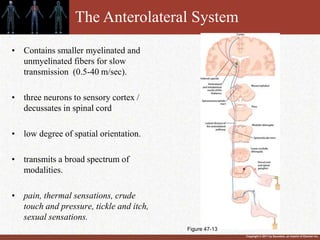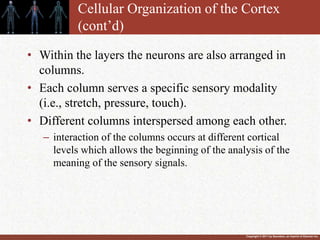The document summarizes somatic sensations and the somatosensory system. It describes:
1) The general organization of the somatosensory system including receptors, pathways to the brain, and processing of sensations. Mechanoreceptors, nociceptors, and thermoreceptors are discussed.
2) Classification of somatic sensations based on function, stimulus, and location. Tactile sensations are subdivided based on the specific receptors.
3) Pathways for transmitting sensory information including the dorsal column-medial lemniscal system and anterolateral system.
4) Organization of the somatosensory cortex and somatosensory homunculus representation of the body.
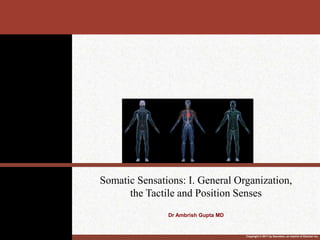
![Copyright © 2011 by Saunders, an imprint of Elsevier Inc.
Sensory system
• For awraeness of external and internal env.
Set up : Receptors >sense stimulus [Sensation or
esthesia]>Transduction > A.P in sensory neuron >
Sensory impulse >
sensory nerve >dorsal root of Spinal chord
>Ascending neurons > sensory areas in brain >
Processing of impulse > perception - [Good touch
/Bad touch]> change in behaviour
• Motor system > efferent pathways through descnding
pathways > ventral horn >spinal motor nerves](https://image.slidesharecdn.com/somaticsensorysystem-200503100332/85/Somatic-sensory-system-2-320.jpg)

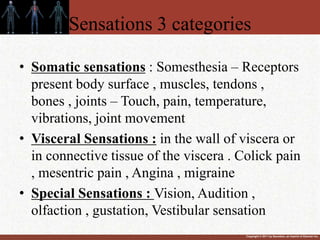


![Copyright © 2011 by Saunders, an imprint of Elsevier Inc.
Classification of somatic sensations
[ Based on Functions ]
• Exteroreceptive – Present on skin and subcutaneous
Tissue. Cutaneous sense organs
• Interoceptors – detect chnge in internal env e.g
Baroreceptors – sense B. P , Osmoceptors change in
osmolality of tissue fluids
• Proprioceptors – detect kinesthesia . Position of body in
space dynamic or static
• Teleceptors – receive stimuli far away from the body – e.g
Auditory](https://image.slidesharecdn.com/somaticsensorysystem-200503100332/85/Somatic-sensory-system-7-320.jpg)
![Copyright © 2011 by Saunders, an imprint of Elsevier Inc.
Classification of somatic sensations
[ Based on Adequate stimulus ]
Mechano receptive - stimulated by mechanical
displacement.
– Tactile: touch, pressure, vibration, tickle, itch
– Proprioceptive: static position, rate of change
Thermoreceptive.
– detect heat and cold.
Nociceptive.
– detect pain and any factor that damages tissue
– A. A delta – fast sharp pain
– B. C polymodal thermal Chemical
Chemoceptors- taste, olfactory
Photoceptors- photon sensitive – rods & cones
.](https://image.slidesharecdn.com/somaticsensorysystem-200503100332/85/Somatic-sensory-system-8-320.jpg)
![Copyright © 2011 by Saunders, an imprint of Elsevier Inc.
Classification of somatic sensations
[ Based on Location ]
Superficial : skin touch , pressure
Deep : Muscle , tendons , bones
Visceral : Visceral pain receptors](https://image.slidesharecdn.com/somaticsensorysystem-200503100332/85/Somatic-sensory-system-9-320.jpg)


![Copyright © 2011 by Saunders, an imprint of Elsevier Inc.
Tactile receptors – large field
Pacinian corpuscle. (~ 1mm) Largest Onion like 20-
70 lamillae
• Location: dermis and deeper tissues
• Function: perception of distant events
through transmitted vibrations;
tool use
• Stimuli: vibration, fine touch, pressure
(250 Hz is optimal)
• Adaptation: very rapid adaptation
• receptive field: entire finger or hand
• type Aβ nerve fibers
Ruffini corpuscle[ Smallest ]
• Location: dermis
• Function: tangential force; hand shape;
motion detection
• Stimuli: skin stretch
• Adaptation: slow adaptation
• receptive field: 60 mm2
• type Aβ nerve fibers
Pacinian corpuscles
Fig. 48-3, Guyton and
Hall Textbook of Medical
Physiology, 13th edition](https://image.slidesharecdn.com/somaticsensorysystem-200503100332/85/Somatic-sensory-system-12-320.jpg)
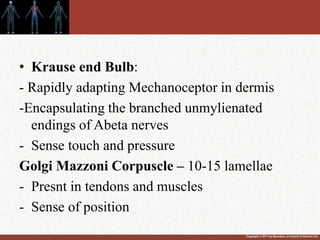



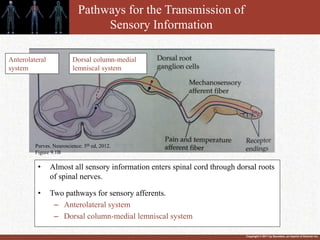
![Copyright © 2011 by Saunders, an imprint of Elsevier Inc.
3 sets of neurons
• 1st Order : Primary Afferent receptor > Dorsal
root Ganglion DRG >dorsal Horns
• 2nd Order : Dorsal Horns > contralateral [ At
level of spinal chord / medulla ] Thalamus
• 3rd Order : SP nuclei in thlamus [ MAIN
SENSORY RELAY CENTRE ]> sensory
cortex
• 4th Order: sensory cortex > cortical sensation
association area](https://image.slidesharecdn.com/somaticsensorysystem-200503100332/85/Somatic-sensory-system-18-320.jpg)

![Copyright © 2011 by Saunders, an imprint of Elsevier Inc.
DORSAL COLUMN PATHWAYS
[ Tract of Goll & Burdach]
• 1st Order :Lower extrimity > medial gracile fasciculus
+ upper extremity > lateral Cuneate fasciculus >
nucleus gracilis / Nucleus cuneatus .[Dorsal Column
nuclei in medulla ]
• 2nd Order : DCN> fibres cross midline to opp side
[decussate]> ascend in medial leminiscus >
contralateral Thalamic nuclei
• 3rd Order VPL nucleus in thalamus > project to
somtosensory cortex postcentral gyrus [Below
sindoor area ] area 3,1,2. lower limbs & genitals in
medial central aprt and upperlimb and fingers
laterally](https://image.slidesharecdn.com/somaticsensorysystem-200503100332/85/Somatic-sensory-system-20-320.jpg)

